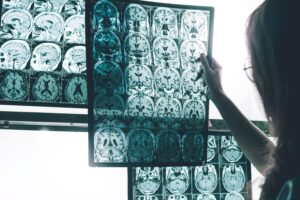When you think of the biological factors driving brain function, your digestive tract may not be the first thing that comes to mind. However, in reality, the gut is in constant communication with the brain. This communication is facilitated by a connection known as the gut-brain axis. Researchers have substantial evidence that the gut-brain axis could impact sleep, hunger, and even neurological conditions like Parkinson’s disease. Read on for an overview of the gut-brain connection and its potential impacts on neurological health.
Parkinson’s Disease and the Gut-Brain Axis
The gut-brain axis is made up of several connections: the vagus nerve, which connects the brain and the gut; key molecules, which are secreted into the bloodstream from our gut microbes; and finally, immune cells, which traffic from the gut to the rest of the body. Together, these connections help the brain process information from the rest of the body, a phenomenon known as interoception that facilitates key signals like hunger and tiredness. Interoception is also vital for important biological processes that we may not perceive in real-time — for example, maintaining appropriate blood sugar levels.
The gut isn’t just connected to the brain; in some ways, it’s a “second brain” all its own. When compared with any structure in the body, the gut contains the largest number of neurons outside the brain — more than 100 million neurons, in fact. These neurons line the digestive tract, forming the enteric nervous system (ENS). Unlike other peripheral nerves, the ENS contains different types of neurons that communicate with one another, allowing the gut’s nervous system to act alone. Interoception aside, the gut is an incredibly powerful structure.
Researchers are just starting to explore the molecules involved in interoception, many of which originate in the gut, either as metabolic byproducts or secretions from existing intestinal bacteria. While the exact properties of some of these molecules remain unclear, experts know they play an important role in interoception. When that communication fails, the body can struggle to self-regulate, contributing to numerous diseases and disorders — Parkinson’s disease included.
Research Supports Link Between Gut Health and Parkinson’s Disease
Parkinson’s disease is a neurodegenerative condition affecting motor neurons in the brain. Scientists have observed numerous connections between Parkinson’s disease and gut dysfunction linked to interoception dysregulation. For example, a 2024 Harvard study found that damage to the upper digestive tract, as seen in patients with chronic ulcers, increases the risk of developing Parkinson’s disease. Other studies have focused on a later symptom of Parkinson’s disease: the development of Lewy bodies, which are clumps of misfolded alpha-synuclein protein in the brain. Some studies suggest that Lewy bodies originate in the gut, traveling directly from the gut to the brain via the vagus nerve. Finally, animal studies have found that certain pathogenic bacterial species in the digestive tract can produce proteins known as curli, which are similar to Lewy bodies. Each of these studies suggests that gut dysfunction could lead to neurological dysfunction.
Next Steps for Neurological Disease Research
Now, researchers are working to apply this knowledge to neurological disease research. Take, for example, Stanford Medicine Professor of Hematology and Genetics Ami Bhatt. Bhatt is currently leading a project alongside neurology professor Kathleen Poston to study how the gut microbiome and immune system may interact to drive Parkinson’s disease. The research team is actively exploring the link between gut-brain health and conditions including Parkinson’s disease and anxiety. Thus far, the team has collected stool and blood samples from more than 100 individuals with Parkinson’s disease, matching them with healthy controls in the same household. The team hopes that, by comparing people who live in the same household, they will be able to eliminate environmental differences that could compromise the microbiome and immune system, creating reliable research controls.
_____
If researchers can establish a strong link between the gut microbiome and Parkinson’s disease, the possibilities for treatment applications are endless. While the understanding of interoception and related processes is still somewhat tenuous, experts like Bhatt and Poston have the potential to drive meaningful change for individuals facing Parkinson’s disease and other neurodegenerative diseases.
To study the impact of the gut on Parkinson’s disease, Scantox Neuro offers several transgenic alpha-synuclein PD mouse models, including Line 61 mice, hA53Ttg mice, and AAV2 hA53T alpha-synuclein induced mice. These animals can be fed a special diet based on your research question. Animals can further be treated with your compound of choice and evaluated for motor and cognitive deficits. The Scantox team can also evaluate brain and gut tissue for disease pathologies using biochemical and histological methods.
Scantox is the leading Nordic preclinical GLP-accredited contract research organization (CRO), delivering the highest grade of pharmacology and regulatory toxicology services since 1977. Scantox focuses on preclinical contract research services, supporting pharmaceutical and biotechnology companies with their drug development projects. Core competencies include explorative and efficacy studies, PK studies, general toxicology studies, local tolerance studies, wound healing studies, and vaccines. To learn more about our services and areas of study, please subscribe to our newsletter. And if you’re interested in partnering with us, please contact us online.











